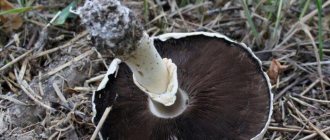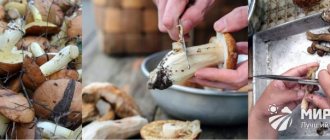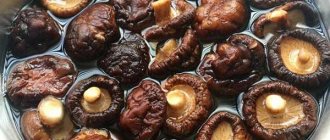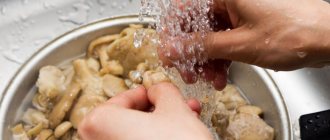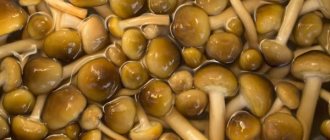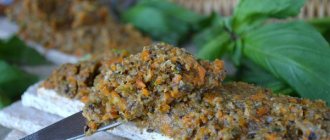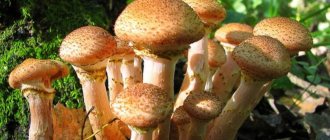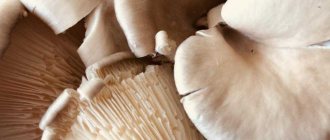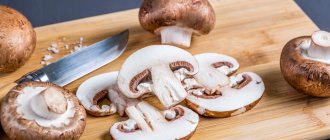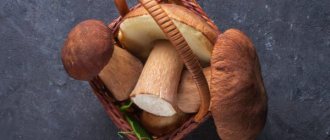If you neglect the rules discussed in this article, you may end up with food poisoning. Of course, it can go away in a mild degree. But where are the guarantees that you will not get serious food poisoning, which will require you to spend more than one day in the hospital? However, if you follow the tips, recommendations and rules from this article, you can avoid the consequences and enjoy delicious mushrooms. So let's find out how to clean champignon mushrooms before cooking them at home.
Basic requirements for processing champignons
If you are collecting forest champignons, then at the collection stage you need to check the mushrooms for worms. And if you are not sure that this is really a champignon (and not a false mushroom, for example), then it is better to ask an experienced mushroom picker for advice (you should always take him into the forest with you) or not to collect this mushroom at all. If you buy champignons in a store, then it is not advisable to do this at the market. Since in such places it is difficult to track the quality and make sure that the mushrooms are really good and edible. In this case, it is better to purchase store branded champignons, since in this case the seller is responsible, and therefore is interested in the high quality of the product.
But how can you determine that champignons are fresh and of high quality, and can be cleaned and then cooked? Good quality champignon has a white or cream color; there should be no strong darkening on the skin (abundant dark spots indicate long-term storage of the mushroom). In this case, the smell should be mushroom (it is very similar to the smell of anise), without notes of dampness or mold. The cut of the champignon leg has a light shade, and the structure of the mushroom itself is dense. These are the signs you can use to determine the freshness and quality of champignons, for which you should check even your own mushrooms. Then the taste and aroma of the cooked champignons will be at a high level, and the risk of poisoning is zero.
Description of the species
The most common mushrooms that grow in Russia are champignons. They are found in all areas, grow throughout the season and have many varieties:
- w. ordinary, or pecheritsa, or sh. real, or sh. meadow;
- w. field, or sh. sidewalk;
- w. garden;
- w. forest;
- w. August;
- w. royal;
- w. curve, or w. distinctly nodulating;
- w. double ring, etc.
Champignons have many varieties
These species have differences in appearance and taste. But they also have common features:
- a dense massive cap of a hemispherical shape in a young organism, which becomes flat with age;
- cap diameter from 2 cm to 12 cm;
- pink plates change color to beige;
- the pulp is aromatic, with an anise note;
- pulp color is white;
- the structure of the leg is dense;
- there are no cavities in the leg.
The color of the cap depends on the species. Sometimes it is white, and sometimes it is brown or brown. The surface of the cap may have scales, but is always dry and pleasant to the touch.
When collecting champignons in the forest, they are sometimes confused with their inedible or poisonous counterparts: the reddish or yellowing champignon, the pale toadstool, or the white fly agaric.
Cleaning forest mushrooms
After you have sorted through the collected mushrooms and checked their quality and freshness, you can proceed to the next stage. Here we will look at whether it is necessary to clean and how to properly clean wild mushrooms before cooking. First of all, you need to soak the mushrooms in cold water for 10-15 minutes. It is not worth carrying out this procedure longer, since the champignons begin to actively absorb moisture and, as a result, slightly lose their taste and aroma. After soaking, dirt, dust and soil will easily come off the champignons.
The next step is to carefully examine the surface of the mushroom. If there are any minor dark spots, they should be cut off with a knife. And if almost the entire cap or leg is darkened, then it is better to get rid of such a champignon. Next, you must remove the skin from the mushroom cap. Fortunately, this is easy to do: use a knife to hook the skin on the edge of the cap and pull - it will easily come off.
In this case, it is necessary to cut off the lower edge of the mushroom stem by a few millimeters. All that remains is to rinse the champignons under running water and place them on a towel or paper napkins so that the fabric absorbs excess moisture. It is important to note that champignons (even freshly picked ones) should not be stored for more than a day, as they begin to deteriorate and darken. Therefore, we cleaned them before frying and immediately need to heat them.
Reviews
Each housewife has her own opinion on the issue of cleaning and washing champignons. Some people absolutely do not accept washing mushrooms, while others, on the contrary, wash them thoroughly.
So, although champignons are recognized as the safest mushrooms, they are recommended to be washed. Although they appear clean, they may contain microorganisms and chemicals. Therefore, it is important to adhere to the basic rules for washing and cleaning champignons, and only after careful preparatory work begin to prepare dishes.
Champignons from the store
People often ask: are store-bought champignons washed? Typically, such mushrooms are grown on special plantations where environmental damage is minimal. However, it is imperative to wash and peel the champignons, even if you bought royal champignons. As in the case of wild mushrooms, store-bought ones must be cleaned of dirt and dust. But in this case there is no need to soak them, just gently brush them with a toothbrush or wipe them with wet wipes (the material must be without any additives).
If you bought mushrooms that have not had the skin removed from their caps, then you need to do it yourself. Fortunately, this is easy to do: use a knife to hook the skin on the edge of the cap and pull - it will easily come off. It is also necessary to cut off dark areas if they are minor. If there are a lot of dark spots, then the question should immediately arise about the quality of the purchased products and whether they should be further cleaned or simply thrown away.
The last step is to wash the champignons under running water and dry them with a towel or thick paper napkin. If you do not plan to cook mushrooms in the near future, then you should not peel the champignons in advance. Since they can spoil, and if this does not happen, they will definitely lose their taste. Now you know how to clean champignons, but the processing of mushrooms before cooking does not end there.
Benefits and harms
Forest and home-grown pecheritsa contain many useful components, microelements, vitamins and amino acids that help improve blood circulation, regulate blood sugar levels, improve overall well-being and stimulate the immune system. In addition, mushrooms act as natural antibiotics that help fight viruses and bacteria.
They are high in fiber but low in calories. Therefore, this product is used in the diet menu. For vegetarians, they replace animal products.
Forest champignons behave like sponges. They absorb all toxins from the environment, so they can be harmful to people with stomach problems. This is a heavy product and is difficult to digest. They should not be abused by people with individual intolerance. Also, do not load your stomach with mushrooms in the evening at dinner. It is better to eat them in the morning or afternoon.
Preparing for frying
Royal champignon is often used for frying and further consumption. It must be prepared before frying in the same way as other mushrooms. It is important to note that champignons are rarely used as a main dish; mushrooms are usually served with rice, potatoes or pasta. This means that in order for the dish to turn out most delicious, it is necessary to properly clean and process the champignons. The first rule: the less moisture is used, the crispier the mushrooms will be. Therefore, you should not keep the champignons in water, but you should rinse them under running water as quickly but effectively as possible.
The detailed preparation of champignons before frying is described in detail above. After the last stage - washing and drying the mushrooms - the champignons must be cut into portions. It is not recommended to fry whole legs and caps, as this will take longer. This means that if exposed to high temperatures for too long, the mushrooms will lose their taste. It is equally important to note that you should not peel the mushrooms in advance. Because if they sit, they will lose their taste, and they may also darken. Therefore, champignons should be cleaned immediately before frying. By the way, you can find recipes for fried mushrooms in the article “Fried champignons for the winter.”
Right choice
It is extremely important to choose the right champignons, especially when it comes to store-bought ones. Good quality champignon has a white or cream color; there should be no strong darkening on the skin (abundant dark spots indicate long-term storage of the mushroom). In this case, the smell should be mushroom (it is very similar to the smell of anise), without notes of dampness or mold. The cut of the champignon leg has a light shade, and the structure of the mushroom itself is dense. These are the signs you can use to determine the freshness and quality of champignons, for which you should check even your own mushrooms. Then the taste and aroma of the cooked champignons will be at a high level, and the risk of poisoning is zero.
Photo gallery: external differences between different types of champignons
Regular champignons are large, with large caps, matte white or pinkish in color.
Garden mushrooms are usually slightly smaller in size than other mushrooms
This variety stands out for its pink cap and long stem.
Double-ringed champignons have dense, elastic and large caps
Nodule champignons can be distinguished by their beige skin tone
Why peel and wash champignons?
It would seem, why clean the champignons before cooking if you still have to boil or fry them afterwards. More experienced mushroom pickers know that mushrooms from the forest are always dirty: they are covered in dust, soil or some other contaminant. In addition, insects or pathogenic microflora can settle inside the cap or stem. By the way, it is not at all recommended to pick mushrooms near the road, as they accumulate car exhaust gases, which can lead to poisoning of the body. And if we are talking about store-bought champignons, then you shouldn’t leave everything to chance. Since on plantations where mushrooms are grown, sanitation rules are not always followed. This means that mushrooms may contain dust and pathogenic microflora, which can lead to poisoning. Therefore, it is extremely important to soak the mushrooms and then clean them according to all the rules described in this article. This means that processing of champignons before cooking is mandatory.
What is needed for cleaning?
If the mushrooms are wild mushrooms, they need to be cleaned more thoroughly. Particles of moss and earth remain on the fruiting bodies, so in addition to washing, you need to update the cut and clean the cap and stem with a small brush.
To clean store-bought champignons, you will need a sharp knife with a long, thin blade. Experienced chefs claim that this knife makes it easier to remove the plates and skirt.
In addition to the knife, you will need a new sponge for washing dishes, a brush, a thick paper towel and a deep bowl. You can also use a colander for added convenience.
Do I need to soak champignons?
You need to soak mushrooms if they are wild mushrooms, that is, you picked them with your own hands. This will allow you to clean them faster and remove most of the dirt. But at the same time, high humidity negatively affects the taste of mushrooms, as they quickly absorb water. This means that store-bought mushrooms need to be cleaned, but not soaked. Firstly, this is not necessary, and secondly, refusing these actions will allow you to completely preserve the taste. Therefore, it is enough to rinse store-bought champignons under running water and quickly dry them with thick napkins or a paper towel. The stage of cleaning champignons was discussed in more detail in the article above.
Cleaning secrets from experienced chefs
If, when washing, the skin is moved away effortlessly with a fingertip, then the skin is removed completely.
How to quickly peel mushrooms - video
To remove the cuticle of large mushrooms, break off the edge of the cap by prying a piece with a knife and pull the skin up. The steps are repeated along the entire cap.
- It is easier to remove the cuticle if the cap is scalded.
- The stems of mushrooms stored in the refrigerator are cut off higher to remove all problem areas.
- After washing the champignons, the mushrooms are immediately dried. You cannot leave champignons in liquid for a long time.
I don't wash it most often. I clean the top film of the hat with a knife and, if the legs are large, then I clean them too. I use the legs for broths, I don’t cook them. I take out the mushroom slices with a spoon and don’t cook with them. If you want to put it raw in a snack, blanch it for a couple of minutes and put it in ice, just like that, to cleanse external irritants.
HELEN CG
Champignons are recognized as the safest mushrooms. However, to be completely confident in the safety of the food, it is important to prepare them for further processing correctly.
If there are no questions about mushrooms collected with your own hands in the forest - they need to be washed and cleaned of needles, blades of grass, small insects and soil, then with store-bought ones the question remains open. They look so clean and fresh that a reasonable question arises: do they need to be washed and cleaned?
How to properly wash mushrooms
The cleaned champignon must be rinsed again under running water to get rid of any remaining debris and small particles of dirt. But it needs to be done correctly. Anyone who has encountered mushrooms knows that champignons are fragile and break easily. Therefore, you should wash them as carefully as possible so as not to break or damage them. Many people who are inexperienced in this matter begin to wash them under the tap, which is definitely not worth doing. It is necessary to fill a basin or bowl with warm or slightly cool water and quickly wash the champignons in it. After this, the peeled mushrooms must be placed on a napkin or towel so that the material absorbs excess moisture. Some people boil the mushrooms in salt water for 5 minutes after washing them. If you are sure that the forest where the champignons were collected has a clean environment and no pollution, then it is not at all necessary to boil in water.
Useful tips
On the legs of large champignons there is often a skirt that is absolutely edible and harmless, so there is no need to cut it off if it does not disturb the aesthetic ideas of the appearance of the finished dish.
You can get rid of microorganisms on wild mushrooms and easily remove the skin from them with your hands by scalding them with boiling water.
Also, in order to disinfect this product and get rid of possible toxins, you can add a little vinegar or lemon juice (100 ml per 10 liters of water) to the rinsing water.
Preparing champignons before harvesting
Depending on further harvesting and heat treatment, the preparation of champignons may vary. Typically, these mushrooms are fried, boiled, baked, frozen or dried. This means that each type of preparation requires its own processing of champignons. But they have one general rule: you need to peel mushrooms immediately before cooking, but not in advance. This point has already been mentioned in the article above, and the point is that peeled champignons quickly deteriorate in the fresh air. Therefore, in order to maintain all the taste at a high level, it is necessary to clean, process and cook as quickly as possible.
Frying
Champignons are often fried in a slow cooker or in a frying pan. You can find recipes for fried mushrooms in the article “Fried champignons for the winter.” It is important to note that champignons are rarely used as a main dish; mushrooms are usually served with rice, potatoes or pasta. This means that in order for the dish to turn out most delicious, it is necessary to properly clean and process the champignons. The first rule: the less moisture is used, the crispier the mushrooms will be. Therefore, you should not keep the champignons in water, but you should rinse them under running water as quickly but effectively as possible.
The detailed preparation of champignons before frying is described in detail above. After the last stage - washing and drying the mushrooms - the champignons must be cut into portions. It is not recommended to fry whole legs and caps, as this will take longer. This means that if exposed to high temperatures for too long, the mushrooms will lose their taste. It is equally important to note that you should not peel the mushrooms in advance. Because if they sit, they will lose their taste, and they may also darken. Therefore, champignons should be cleaned immediately before frying.
Cooking
Before cooking, it is extremely important to rinse the champignons thoroughly (this must be done even more thoroughly than before frying or other methods of preparation). At the same time, it is important to trim the leg, although many housewives forget to do this. But removing small dark spots (provided they are small) is not necessary. Since during cooking all harmful substances will come out anyway, moreover, darkening after such heat treatment will not be visible. By the way, if you have a bad environment in your area, then after cleaning the champignons you must boil them in salt water for 5 minutes. This will reduce the risk of poisoning or infection to 0.
Baking
When baking, in most cases, large champignon caps are used, from which all the plates are removed. To do this as simply as possible, you need to soak the mushrooms in warm or slightly cool water for 5-10 minutes. In this case, you need to dilute 1-2 tablespoons of wheat flour in the liquid. This substance will act as an abrasive substance, which will not only make it easy to remove the plates, but also clean the caps from the skin. After this processing and cleaning, the champignons can be baked according to the chosen recipe.
Freezing
Before freezing, be sure to cut off all darkened spots. Since while in a refrigerated state, the mushrooms begin to darken. And if there are dark spots on the surface in advance, then this process will go much faster. It is worth noting that many recipes do not write, but it is advisable to cut the mushrooms into slices and sprinkle with lemon juice, then wrap in cling film. By the way, if you plan to cook or stew frozen champignons, you do not need to defrost the mushrooms first. You can save time and send them frozen to a saucepan or slow cooker.
Drying
There is no need to wash champignons before drying. Since wet mushrooms, according to the laws of physics, will dry many times longer. Because of this, the taste may suffer, and the pulp will not be as aromatic. 2-3 hours before drying, the mushrooms can be quickly rinsed in water to remove dirt and dust (you can even soak them for 5 minutes), and then be sure to place them on a towel so that the fabric absorbs all the moisture. By the way, damaged and broken champignons are not suitable for drying. Therefore, during processing, when you peel mushrooms, you need to take careful steps so as not to accidentally break the stem or cap.
Fresh mushrooms
Some mushroom gourmets prefer to eat fresh champignons. But in this case, the mushrooms require special treatment to destroy all pathogenic microflora. You need to clean the champignons thoroughly, removing all darkened areas, and do not forget to rinse them in a bowl of water. But even with the most careful processing, there remains a risk of poisoning from fresh mushrooms. To reduce it to zero, you need to place fresh champignons in the oven or a conventional oven for 30-60 seconds. You can also boil the mushrooms in salt water for 5 minutes, which will also destroy all pathogenic microflora and harmful substances.
Quick cleaning method
Despite its apparent simplicity, preparing and cleaning champignons is a rather labor-intensive process. But experienced mushroom pickers have come up with enough ways to speed up and simplify their work.
On large caps, you need to pry the skin from the edge with a knife (or other sharp object suitable for these purposes) and, moving towards the center, moving in a circle, remove all the peel in strips. When pulling off the skin, you need to be careful not to cut off too much of the fruiting body.
You can also quickly clean up using a 10 cm square piece of coarse sandpaper. It will easily remove the skin, practically without touching the cap itself. But this method has a slight drawback - the paper will have to be washed frequently in water so that it does not clog.
Why Easter cakes are baked, where the tradition of painting eggs came from - these and other traditions are in our article. Read how to make a delicious and aromatic cake in a slow cooker.
Read our article on how to cook a delicious rice casserole in a slow cooker.
How to properly clean champignons
There are several more rules for processing champignons before cooking, which are recommended for every mushroom lover to follow. Of course, at some points they will overlap with those that have already been written in the article above. By the way, if you still have questions on the topic of how to clean champignons with your own hands, you can ask them in the comments under the article. Well, most of your questions can be answered in the article below.
What you need to clean mushrooms
To clean mushrooms you need several liters of water, thick napkins or paper towels, a basin, a container for champignons, the champignons themselves, a knife and, of course, free time. By the way, for easier peeling of the mushroom cap, you can add 1-2 tablespoons of flour to the water in which you will soak the mushrooms. In this case, the skin will easily come away from the cap; you only need to pick it up. The process of how to clean champignons with your own hands will be discussed in the article below.
How to properly clean champignons
Proper cleaning of champignons will provide a tasty, healthy, and most importantly, safe mushroom dish. First of all, you need to soak the mushrooms in cold water for 10-15 minutes. It is not worth carrying out this procedure longer, since the champignons begin to actively absorb moisture and, as a result, slightly lose their taste and aroma. After soaking, dirt, dust and soil will easily come off the champignons.
The next step is to carefully examine the surface of the mushroom. If there are any minor dark spots, they should be cut off with a knife. And if almost the entire cap or leg is darkened, then it is better to get rid of such a champignon. Next, you must remove the skin from the mushroom cap. Fortunately, this is easy to do: use a knife to hook the skin on the edge of the cap and pull - it will easily come off.
In this case, it is necessary to cut off the lower edge of the mushroom stem by a few millimeters. All that remains is to rinse the champignons under running water and place them on a towel or paper napkins so that the fabric absorbs excess moisture. It is important to note that champignons (even freshly picked ones) should not be stored for more than a day, as they begin to deteriorate and darken. Therefore, we cleaned them before frying and immediately need to heat them.
Video: how to clean mushrooms
Of course, it may be difficult to understand from the text how to clean champignons before cooking. Therefore, I strongly recommend watching a video in which the author explains in detail the process of processing mushrooms before further thermal cooking. Be sure to turn on the sound, as the video not only shows, but also tells you some useful tips and life hacks for processing champignons before cooking. Enjoy watching!
Video: dry processing method
In the article above it was noted more than once that the drier the champignons are, the tastier they will be in further preparation. Therefore, I recommend looking at another way to process mushrooms at home. In this case, the author practically does not use water, but cleans the champignons with flour. Of course, this process is somewhat more expensive (after all, flour is more expensive than water), but the mushrooms then turn out to be much tastier, more appetizing and brighter. If we talk about the complexity of processing, then both the dry and wet methods are equal in this indicator. After watching a video with instructions on how to clean champignons, you can choose the option that suits you.
How to prepare mushrooms for further cooking: frying, boiling, drying, freezing
Champignons are often fried in a slow cooker or in a frying pan. You can find recipes for fried mushrooms in the article “Fried champignons for the winter.” It is important to note that champignons are rarely used as a main dish; mushrooms are usually served with rice, potatoes or pasta. This means that in order for the dish to turn out most delicious, it is necessary to properly clean and process the champignons. The first rule: the less moisture is used, the crispier the mushrooms will be. Therefore, you should not keep the champignons in water, but you should rinse them under running water as quickly but effectively as possible.
The detailed preparation of champignons before frying is described in detail above. After the last stage - washing and drying the mushrooms - the champignons must be cut into portions. It is not recommended to fry whole legs and caps, as this will take longer. This means that if exposed to high temperatures for too long, the mushrooms will lose their taste. It is equally important to note that you should not peel the mushrooms in advance. Because if they sit, they will lose their taste, and they may also darken. Therefore, champignons should be cleaned immediately before frying.
Before cooking, it is extremely important to rinse the champignons thoroughly (this must be done even more thoroughly than before frying or other methods of preparation). At the same time, it is important to trim the leg, although many housewives forget to do this. But removing small dark spots (provided they are small) is not necessary. Since during cooking all harmful substances will come out anyway, moreover, darkening after such heat treatment will not be visible. By the way, if you have a bad environment in your area, then after cleaning the champignons you must boil them in salt water for 5 minutes. This will reduce the risk of poisoning or infection to 0.
Before freezing, be sure to cut off all darkened spots. Since while in a refrigerated state, the mushrooms begin to darken. And if there are dark spots on the surface in advance, then this process will go much faster. It is worth noting that many recipes do not write, but it is advisable to cut the mushrooms into slices and sprinkle with lemon juice, then wrap in cling film. By the way, if you plan to cook or stew frozen champignons, you do not need to defrost the mushrooms first. You can save time and send them frozen to a saucepan or slow cooker.
There is no need to wash champignons before drying. Since wet mushrooms, according to the laws of physics, will dry many times longer. Because of this, the taste may suffer, and the pulp will not be as aromatic. 2-3 hours before drying, the mushrooms can be quickly rinsed in water to remove dirt and dust (you can even soak them for 5 minutes), and then be sure to place them on a towel so that the fabric absorbs all the moisture. By the way, damaged and broken champignons are not suitable for drying. Therefore, during processing, when you peel mushrooms, you need to take careful steps so as not to accidentally break the stem or cap.
To wash or not to wash
Many people are sometimes too lazy to wash champignons, which is why they refuse this procedure. But you need to soak the mushrooms, especially if they are wild mushrooms, that is, you picked them with your own hands. This will allow you to clean them faster and remove most of the dirt. But at the same time, high humidity negatively affects the taste of mushrooms, as they quickly absorb water. This means that store-bought mushrooms need to be cleaned, but not soaked. Firstly, this is not necessary, and secondly, refusing these actions will allow you to completely preserve the taste. Therefore, it is enough to rinse store-bought champignons under running water and quickly dry them with thick napkins or a paper towel. The stage of cleaning champignons was discussed in more detail in the article above.
How to clean champignons
Cleaning champignons with your own hands is not difficult. Detailed instructions have already been discussed in the article above. Here I just wanted to describe in a little more detail the process of peeling the skin from the mushroom cap. It will be much easier to do this if you first soak the mushrooms in water and flour or at least sprinkle them with this dry mixture. Then you need to use a knife to pick up the skin from the edge of the mushroom cap and pull it until it completely comes off the champignon. Usually this does not require much effort, so mushrooms are quick and easy to clean.
How to quickly peel mushrooms - video
I think many will remember how in childhood, after picking mushrooms, we had to sit and clean them until the evening with the whole family. Of course, this has its joyful moments; it is especially gratifying that the family is united by a common cause. But you still want to do it quickly in order to have more rest or redo other daily tasks. This can be done using the method described in this video. The author tells in detail how to quickly clean champignons with your own hands. I recommend watching it with sound, as the information is no less useful than what is shown. Enjoy watching!
Little tricks for cooking champignons
The first trick, which has been discussed more than once in this article, is that mushrooms need to be kept in water as little as possible. Since the leg and cap of the champignon quickly absorb moisture, which is why they lose their best taste. Therefore, it is not advisable to soak wild mushrooms for more than 10-15 minutes, and purchased champignons do not need to be soaked at all during processing. The second trick is that it is advisable to fry the mushroom caps and legs in crushed form. Thanks to this, you will save time on heat treatment, and the mushrooms will acquire a more appetizing and delicate taste.
Do I need to clean out champignon caps if they burst?
It happens that whole caps are used for a dish, but when washed, the mushroom cracks due to lack of juiciness. If it is not possible to purchase other mushrooms, and you need to prepare the dish, do the following:
- Place the mushrooms in warm water and leave for 15-20 minutes;
- Clean dirty areas with a cloth and rinse additionally with warm water;
- If necessary, make a new cut on the stem, clean it, put it in water again and immediately remove it.
This way, even the most fragile mushrooms will remain intact.
How to process for raw consumption
There are people who love to eat raw champignons. But in this case, the mushrooms require special treatment to destroy all pathogenic microflora. You need to clean the champignons thoroughly, removing all darkened areas, and do not forget to rinse them in a bowl of water. But even with the most careful processing, there remains a risk of poisoning from fresh mushrooms. To reduce it to zero, you need to place fresh champignons in the oven or a conventional oven for 30-60 seconds. You can also boil the mushrooms in salt water for 5 minutes, which will also destroy all pathogenic microflora and harmful substances.
Important Rules
To properly prepare mushrooms, adhere to the following rules:
- Cleaning mushrooms always begins with sorting them. During which all spoiled specimens are thrown away, as well as mushrooms with areas of rot.
- The legs must be trimmed, regardless of where they were grown. When collected in greenhouses, they are cut off and placed directly in a bucket. As a result, dirt gets inside the leg. When collecting champignons in the forest, experienced mushroom pickers turn them out of the mycelium, so the remains of mycelium and soil remain on the stems. When trimming the stem, follow the rules - the longer the mushroom has been stored, the larger part of the stem is cut off.
- Damaged areas are cut off. The darkened areas on the stem are carefully scraped off with a knife. Only healthy parts of the mushroom are eaten.
Forest mushrooms are quite fragile and pre-treatment can damage their integrity; to increase density, before cleaning, place them in warm water for 20 minutes, then remove them and subject them to the necessary procedure.
Sources
- https://legkovmeste.ru/poleznye-sovety/kak-pravilno-chistit-i-myit-shampinonyi.html
- https://agronomu.com/bok/6184-kak-pravilno-chistit-shampinony-i-nado-li-ih-myt.html
- https://FB.ru/article/402049/kak-obrabotat-shampinonyi-pered-gotovkoy-sovetyi-spetsialistov
- https://babyben.ru/kulinariya/chistka-shampinonov-dlya-zharki-varki-i-farshirovki-sposoby-kak-pravilno-chistit-i-obrabotat-svezhie-i-pokupnye-griby-shampinony-pered-prigotovleniem- kak-ochistit-shampinony-ot-plenki-myt-varit.html
- https://ferma.expert/griby/shampinony/nuzhno-li-chistit-i-myt-shampinony/
- https://nyamkin.ru/advice/kak-pravilno-chistit-shampinony
Storage Features
You cannot store peeled champignons for a long time, as they begin to darken and then spoil. In general, it is advisable to clean and prepare freshly picked mushrooms during the same day: boil, fry, freeze, dry, bake, or in some other way. And depending on the heat treatment, further storage will depend. But in most cases we are talking about a regular refrigerator. Once again, it is worth noting that peeled champignons need to be cooked for several hours, and it is not necessary to put them in the refrigerator in the meantime.
To summarize
Here is such a simple processing of champignons before cooking, which is absolutely required. If you neglect the rules described above, you can be seriously poisoned by unprocessed mushrooms. By the way, do not forget that it is not recommended to collect mushrooms growing near roads, highways and large cities. The fact is that in these areas there are a lot of emissions from cars and factories, and mushrooms, like sponges, absorb all this. This means that the mushroom pulp becomes poisonous and dangerous to human life. Therefore, I strongly recommend going to pick mushrooms as far as possible from cities and highways into the forest, the main thing is not to get lost. If you still have any questions, ask them in the comments below the article. We answer them promptly and in as much detail as possible. Bon appetit, see you soon!
